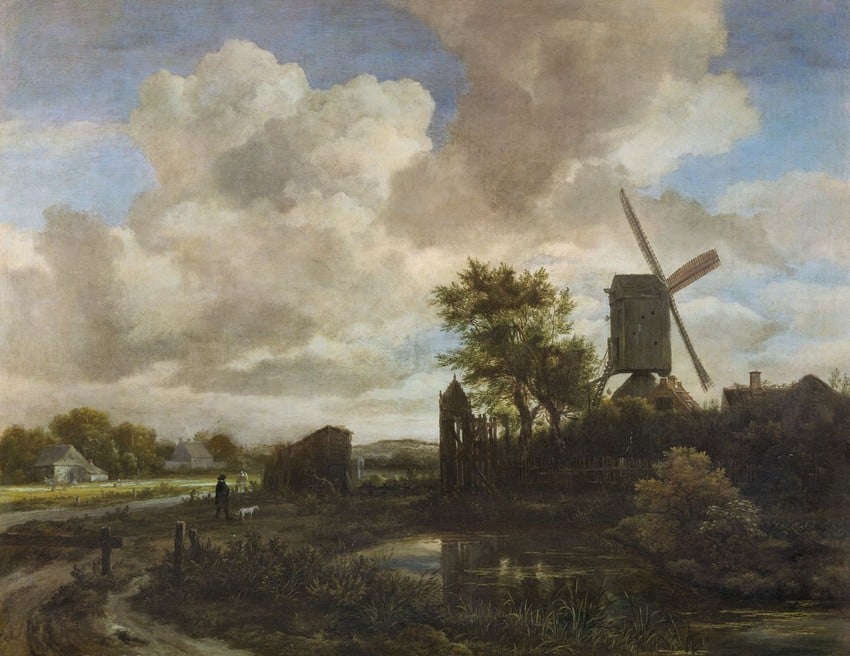
Dutch Landscapes
WILLEM VAN DE VELDE THE YOUNGER (1633-1707)
A Calm: A States Yacht under Sail close to the Shore with many other Vessels
c. 1655Oil on panel | 59.8 x 71.5 cm (support, canvas/panel/stretcher external) | RCIN 405328
Willem van de Velde (1633-1707) was the son of the marine painter of the same name and brother of Adriaen (also a painter); he studied with his father and with Simon de Vlieger. His earliest paintings, from the early 1650s, include many images like this and 'A Calm' (RCIN 407275), depicting perfectly calm seas with a dense arrangement of ships, sometimes now called ‘naval parades’. The type was invented by marine painters of the previous generation, in particular Jan van de Cappelle, and would seem to depict the Netherlands’ inland sea, the Zuider Zee, which included many of the most important Dutch ports – Amsterdam, Hoorn, Enkhuizen and Kampen – and where large numbers of ships might lie at anchor in relative safety. Though the atmosphere might be studied from the life, the particular variety of shipping in such close proximity looks imaginary. Both these ‘calms’ have states yachts providing an obvious focus of interest, in this case by its size, in the case of RCIN 407275 by it central position and the fact that a dignitary is being rowed out to it in a barge. It is tempting to read both images as a ‘Great Republic of Vessels’ with every type, size and function of shipping from the humblest upwards, peaceably coexisting under the protection of the senatorial government yacht.
The ships in question can be identified through the comparison with the drawings of Willem van de Velde the Elder; to the left of the yacht is a pont in the foreground, behind this a kaag and hoekers in the distance. Reading to the right from the yacht is a kaag, two smalschepen, a hoeker next to a Pont and a weyschuit in the right foreground.
The artists already mentioned as Willem van de Velde’s inspiration for images such as this – Simon de Vlieger and Jan van de Cappelle – were both exponents of the ‘tonal’ style of seascape, initially pioneered by Jan Porcellis. The best way of understanding this painting is to imagine Willem van de Velde setting out to paint a tonal painting and striving not to sacrifice any of its atmospheric unity, while at the same time adding those elements which tonal painting lacks – bright colour and a thick, opaque and smooth paint surface. In the lower part of this painting the boats, ripples and sand are beautifully unified in a close, grey-brown tonal range. This is also a perfect example of ‘going with the grain’, an effect whereby the paint follows and suggests the grain of the wood panel while at the same time evoking the clinker boats and ripples of water. The sky contains thicker paint, purer white and brighter blue than any tonal painting, and yet colour and tone are controlled in such a way as to retain an effect of atmospheric unity. By this means the viewer is made to feel that there is a veil of moist, sunlit air between their eye and every surface in the painting.
Text adapted from Dutch Landscapes, London, 2010
The ships in question can be identified through the comparison with the drawings of Willem van de Velde the Elder; to the left of the yacht is a pont in the foreground, behind this a kaag and hoekers in the distance. Reading to the right from the yacht is a kaag, two smalschepen, a hoeker next to a Pont and a weyschuit in the right foreground.
The artists already mentioned as Willem van de Velde’s inspiration for images such as this – Simon de Vlieger and Jan van de Cappelle – were both exponents of the ‘tonal’ style of seascape, initially pioneered by Jan Porcellis. The best way of understanding this painting is to imagine Willem van de Velde setting out to paint a tonal painting and striving not to sacrifice any of its atmospheric unity, while at the same time adding those elements which tonal painting lacks – bright colour and a thick, opaque and smooth paint surface. In the lower part of this painting the boats, ripples and sand are beautifully unified in a close, grey-brown tonal range. This is also a perfect example of ‘going with the grain’, an effect whereby the paint follows and suggests the grain of the wood panel while at the same time evoking the clinker boats and ripples of water. The sky contains thicker paint, purer white and brighter blue than any tonal painting, and yet colour and tone are controlled in such a way as to retain an effect of atmospheric unity. By this means the viewer is made to feel that there is a veil of moist, sunlit air between their eye and every surface in the painting.
Text adapted from Dutch Landscapes, London, 2010




